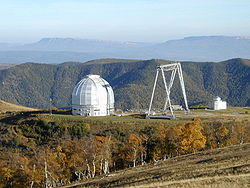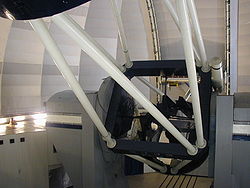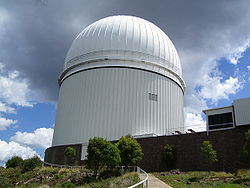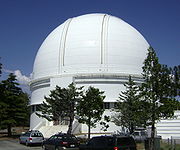
BTA-6
Encyclopedia


The BTA-6 is a 6 m aperture optical telescope
Optical telescope
An optical telescope is a telescope which is used to gather and focus light mainly from the visible part of the electromagnetic spectrum for directly viewing a magnified image for making a photograph, or collecting data through electronic image sensors....
at the Special Astrophysical Observatory located in the Zelenchuksky District
Zelenchuksky District
Zelenchuksky District is an administrative and a municipal district , one of the ten in the Karachay-Cherkess Republic, Russia. Its administrative center is the rural locality of Zelenchukskaya. District's population: 53,414 ; Population of Zelenchukskaya accounts for 39.4% of the district's...
on the north side of the Caucasus Mountains
Caucasus Mountains
The Caucasus Mountains is a mountain system in Eurasia between the Black Sea and the Caspian Sea in the Caucasus region .The Caucasus Mountains includes:* the Greater Caucasus Mountain Range and* the Lesser Caucasus Mountains....
in southern Russia
Russia
Russia or , officially known as both Russia and the Russian Federation , is a country in northern Eurasia. It is a federal semi-presidential republic, comprising 83 federal subjects...
. The BTA-6 achieved first light in late 1975, using a computer-controlled alt-az configuration, supporting a single piece glass mirror.
History
For many years the primary world-class observatory in the Soviet UnionSoviet Union
The Soviet Union , officially the Union of Soviet Socialist Republics , was a constitutionally socialist state that existed in Eurasia between 1922 and 1991....
was the Pulkovo Observatory
Pulkovo Observatory
The Pulkovo Astronomical Observatory астрономи́ческая обсервато́рия Росси́йской акаде́мии нау́к), the principal astronomical observatory of the Russian Academy of Sciences, located 19 km south of Saint Petersburg on Pulkovo Heights...
outside Saint Petersburg
Saint Petersburg
Saint Petersburg is a city and a federal subject of Russia located on the Neva River at the head of the Gulf of Finland on the Baltic Sea...
, originally built in 1839. Like many observatories of its era, it was primarily dedicated to timekeeping, weather, navigation and similar practical tasks, with a secondary role for scientific research. Around its 50th anniversary a new 76 cm telescope, then the world's largest, was installed for deep space observation. Further upgrades were limited due to a variety of factors, while a number of much larger instruments were built around the world over the next few decades.
In the 1950s the Soviet Academy of Sciences decided to build a new telescope that would allow first-rate deep space observation. Design work started at Pulkovo in 1959 under the leadership of future Lenin Prize
Lenin Prize
The Lenin Prize was one of the most prestigious awards of the USSR, presented to individuals for accomplishments relating to science, literature, arts, architecture, and technology. It was created on June 23, 1925 and was awarded until 1934. During the period from 1935 to 1956, the Lenin Prize was...
winner Bagrat K. Ioannisiani
Bagrat Ioannisiani
Bagrant Ioannisiani was a Soviet telescope designer of Armenian descent. He was the chief designer of the BTA-6, one of the largest telescopes in the world.He was awarded the Lenin Prize in 1957....
. With the goal of building the largest telescope in the world, a title long held by the 200 inch (5 m) Hale telescope
Hale telescope
The Hale Telescope is a , 3.3 reflecting telescope at the Palomar Observatory in California, named after astronomer George Ellery Hale. With funding from the Rockefeller Foundation, he orchestrated the planning, design, and construction of the observatory, but did not live to see its commissioning...
at the Palomar Observatory
Palomar Observatory
Palomar Observatory is a privately owned observatory located in San Diego County, California, southeast of Pasadena's Mount Wilson Observatory, in the Palomar Mountain Range. At approximately elevation, it is owned and operated by the California Institute of Technology...
, the team settled on a new design of 6 m (236 inches). This is about the maximum size a solid mirror can have without suffering from major distortion when tilted.
A telescope's theoretical angular resolution
Angular resolution
Angular resolution, or spatial resolution, describes the ability of any image-forming device such as an optical or radio telescope, a microscope, a camera, or an eye, to distinguish small details of an object...
is defined by its aperture, which in the case of the BTA's 6 m leads to a resolution of about 0.021 arcseconds. Atmospheric effects overwhelm this, so it becomes important to locate high-resolution instruments at high altitudes in order to avoid as much of the atmosphere as possible. The Pulkovo site, at 75 m above sea level, was simply not suitable for a high-quality instrument. While BTA was being designed another instrument, the RATAN-600 radio telescope
Radio telescope
A radio telescope is a form of directional radio antenna used in radio astronomy. The same types of antennas are also used in tracking and collecting data from satellites and space probes...
, was also designed. It was decided that the two instruments should be co-located, allowing the construction of a single site to house the crews. To select the site, sixteen expeditions were dispatched to various regions of the USSR, and the final selection was in the North Caucasus Mountains near Zelenchukskaya
Zelenchukskaya
The Special Astrophysical Observatory , or SAO RAS for short, is an astronomical observatory, set up in 1966 in the USSR, now operated by the Russian Academy of Sciences. Based in the Bolshoi Zelenchuk Valley of the Greater Caucasus near the village of Nizhny Arkhyz, the observatory houses the...
at a height of 2,070 m. In 1966 the Special Astrophysical Observatory was formed to host the BTA-6 and RATAN-600.
BTA's first images were obtained on the night of 28/29 December 1975. After a break-in period, BTA was declared fully operational in January 1977. Almost immediately after it opened, rumors started in the West that something was seriously wrong with the telescope. It was not long before many dismissed it as a white elephant
White elephant
A white elephant is an idiom for a valuable but burdensome possession of which its owner cannot dispose and whose cost is out of proportion to its usefulness or worth...
, so much so that it was even mentioned in James Oberg
James Oberg
James Edward Oberg is an American space journalist and historian, regarded as an expert on the Russian space program.-Biography:...
's 1988 book Uncovering Soviet Disasters.
The original mirror had significant imperfections, attributed to the Russians' inexperience with large optics. These included cracks on the surface, which were covered with black cloth to hide their effects. According to Ioannisiani, the primary directed 61% of the incoming light into a 0.5 arcsecond circle and 91% into one with twice the diameter.
A second mirror, with an improved figure and no cracks, was installed in 1978. Although this improved the major problems, a number of unrelated issues continued to seriously degrade the overall performance of the telescope. In particular, the site is downwind of a number of other peaks in the Caucasus, so the site's astronomical seeing
Astronomical seeing
Astronomical seeing refers to the blurring and twinkling of astronomical objects such as stars caused by turbulent mixing in the Earth's atmosphere varying the optical refractive index...
is not nearly as good as the primary sites like Mauna Kea
Mauna Kea
Mauna Kea is a volcano on the island of Hawaii. Standing above sea level, its peak is the highest point in the state of Hawaii. However, much of the mountain is under water; when measured from its oceanic base, Mauna Kea is over tall—significantly taller than Mount Everest...
, La Palma
La Palma
La Palma is the most north-westerly of the Canary Islands. La Palma has an area of 706 km2 making it the fifth largest of the seven main Canary Islands...
or Chile
Chile
Chile ,officially the Republic of Chile , is a country in South America occupying a long, narrow coastal strip between the Andes mountains to the east and the Pacific Ocean to the west. It borders Peru to the north, Bolivia to the northeast, Argentina to the east, and the Drake Passage in the far...
; observations with a resolution better than an arcsecond are rare, and 2 arcseconds is considered good. Under favourable conditions (little temperature difference between the main mirror, the air inside the dome and also that outside of it), the seeing is limited by the atmospheric turbulence, the width of the seeing disc (FWHM) being ~1 arcsecond for 20% of observational nights. Weather is another significant factor; on average observing takes place on fewer than half of the nights throughout the year.
Perhaps the most annoying problem is the huge thermal mass of the primary, the telescope as a whole, and the enormous dome. Thermal effects are so significant in the primary that it can tolerate only a 2 degree Celsius change per day and still retain a usable figure. If the temperatures of the primary and the outside air differ by even 10 degrees, observations become impossible. SAO astronomers planned to address some of this problem with a new mirror made of ultra low expansion Sitall
Sitall
Sitall aka Sitall CO-115M or Astrositall, is a crystalline glass ceramic material with ultra low coefficient of thermal expansion . It was originally manufactured in the former Soviet Union and was used in the making of primary mirrors for the Russian Maksutov telescopes, but since dissolution has...
glass, but this upgrade is not recorded as having taken place. With a glass ceramic (Sitall) primary mirror, it would be possible to reduce the thickness from 65 to 40 cm, reducing also thermal inertia. The large size of the dome itself means there are thermal gradients within it that compound these problems. Refrigeration within the dome offsets some of these issues.
Despite these shortcomings, the BTA-6 remains a significant instrument, able to image objects as faint as the 26th magnitude
Apparent magnitude
The apparent magnitude of a celestial body is a measure of its brightness as seen by an observer on Earth, adjusted to the value it would have in the absence of the atmosphere...
. This makes it especially useful for tasks such as spectroscopy
Spectroscopy
Spectroscopy is the study of the interaction between matter and radiated energy. Historically, spectroscopy originated through the study of visible light dispersed according to its wavelength, e.g., by a prism. Later the concept was expanded greatly to comprise any interaction with radiative...
and speckle interferometry where light gathering performance is more important than resolution. BTA has made several contributions using these techniques.
Speckle Interferometry techniques allow today the diffraction-limited resolution of 0,02 arcseconds of 15th magnitude objects under good seeing conditions (EMCCD-based Speckle Interferometer - PhotonMAX-512B camera - in active use since 2007). "In contrast to the adaptive optics, which is effective today mainly in the infrared, speckle interferometry can be used for observations in visible and near UV bands. In addition, speckle interferometry is realizable under poor atmospheric conditions, while the adaptive optics always needs the best seeing".
Description
The BTA primary is a 605 cm f/4 mirror. This is a relatively slow primary compared to similar instruments; the Hale is a 5 m f/3.3. The telescope optics are a Ritchey-Chrétien telescopeRitchey-Chrétien telescope
A Ritchey–Chrétien telescope is a specialized Cassegrain telescope designed to eliminate coma, thus providing a large field of view compared to a more conventional configuration. An RCT has a hyperbolic primary and a hyperbolic secondary mirror. It was invented in the early 1910s by American...
design, albeit without the traditional Cassegrain-style focus. Due to its large primary, the image scale at the prime focus is 8.6 arc seconds per millimeter, about the same as the Cassegrain
Cassegrain reflector
The Cassegrain reflector is a combination of a primary concave mirror and a secondary convex mirror, often used in optical telescopes and radio antennas....
ian focus of a 4 m telescope. This eliminates the need for a secondary, and instead the observing instruments are placed at the prime focus. For secondary roles, two Nasmith foci
Nasmyth telescope
The Nasmyth telescope, also called Nasmyth-Cassegrain, is a reflecting telescope developed by James Nasmyth. It is a modified form of a Cassegrain telescope, mounted on an alt-azimuth mount.-Scheme:...
can be used, with an effective f/30.
The long focal length and lack of a secondary placed in front of the prime focus makes for a long telescope overall; BTA's main tube is 26 m long. This would have required a massive equatorial mount
Equatorial mount
An equatorial mount is a mount for instruments that follows the rotation of the sky by having one rotational axis parallel to the Earth's axis of rotation. This type of mount is used for astronomical telescopes and cameras...
, so BTA instead uses a altazimuth mount
Altazimuth mount
An altazimuth or alt-azimuth mount is a simple two-axis mount for supporting and rotating an instrument about two mutually perpendicular axes; one vertical and the other horizontal. Rotation about the vertical axis varies the azimuth of the pointing direction of the instrument...
with computer controls to keep the motion of the sky still in the view. Since this also results in the rotation of the field of view
Angle of view
In photography, angle of view describes the angular extent of a given scene that is imaged by a camera. It is used interchangeably with the more general term field of view....
as the telescope moves, the primary focus area containing the instruments is also rotated to offset this effect. With the widespread adoption of computer controls for almost all aspects of telescope operations, this style of mounting, pioneered on BTA, has since become common.
When working at the prime focus, a Ross coma corrector is used. The field of view, with coma and astigmatism corrected at a level of less than 0.5 arcseconds, is about 14 arcminutes. It takes about three to four minutes to switch from one focus to another, making it possible to use several different instrument sets in a short period of time.
BTA-6 is enclosed in a massive dome, 53 m tall at the peak, and 48 m tall from the cylindrical base it sits on. The dome is much larger than required, and there is a gap of 12 m between the telescope and dome.
Contemporaries on debut
The BTA-6 lit up at the end of 1975, topping the Palomar Hale in aperture by nearly a meter and causing much consternation among NATO countries.Largest telescopes in early 1976:
| # | Name / Observatory |
Image | Aperture | M1 Area |
Altitude | First Light |
Special advocate |
|---|---|---|---|---|---|---|---|
| 1 | BTA-6 Special Astrophysical Obs |
238 inch 605 cm |
26 m² | 2070 m (6791 ft) |
1975 | Mstislav Keldysh Mstislav Keldysh Mstislav Vsevolodovich Keldysh was a Soviet scientist in the field of mathematics and mechanics, academician of the USSR Academy of Sciences , President of the USSR Academy of Sciences , three times Hero of Socialist Labor , fellow of the Royal Society of Edinburgh . He was one of the key figures... |
|
| 2 | Hale Telescope Hale telescope The Hale Telescope is a , 3.3 reflecting telescope at the Palomar Observatory in California, named after astronomer George Ellery Hale. With funding from the Rockefeller Foundation, he orchestrated the planning, design, and construction of the observatory, but did not live to see its commissioning... Palomar Obs. Palomar Observatory Palomar Observatory is a privately owned observatory located in San Diego County, California, southeast of Pasadena's Mount Wilson Observatory, in the Palomar Mountain Range. At approximately elevation, it is owned and operated by the California Institute of Technology... |
 |
200 inch 508 cm |
20 m² | 1713 m (5620 ft) |
1949 | George Ellery Hale George Ellery Hale George Ellery Hale was an American solar astronomer.-Biography:Hale was born in Chicago, Illinois. He was educated at MIT, at the Observatory of Harvard College, , and at Berlin . As an undergraduate at MIT, he is known for inventing the spectroheliograph, with which he made his discovery of... |
| 3 | Mayall Telescope Nicholas U. Mayall Telescope The Nicholas U. Mayall Telescope is a four meter reflector telescope located at the Kitt Peak National Observatory and named after Nicholas U. Mayall. It saw first light on February 27, 1973. Initial observers included: D. Crawford, Nicholas Mayall, and Arthur Hoag. It was dedicated on June 20,... Kitt Peak National Obs. Kitt Peak National Observatory The Kitt Peak National Observatory is a United States astronomical observatory located on 2,096 m Kitt Peak of the Quinlan Mountains in the Arizona-Sonoran Desert on the Tohono O'odham Nation, southwest of Tucson... |
158 inch 401 cm |
12 m² | 2120 m (6955 ft) |
1973 | Nicholas U. Mayall | |
| 4 | Anglo-Australian Telescope Anglo-Australian Telescope The Anglo-Australian Telescope is a 3.9 m equatorially mounted telescope operated by the Australian Astronomical Observatory and situated at the Siding Spring Observatory, Australia at an altitude of a little over 1100 m... Siding Spring Obs. Siding Spring Observatory Siding Spring Observatory near Coonabarabran, New South Wales, Australia, part of the Research School of Astronomy & Astrophysics at the Australian National University , incorporates the Anglo-Australian Telescope along with a collection of other telescopes owned by the Australian National... |
 |
153 inch 389 cm |
12 m² | 1742 m (5715 ft) |
1974 | Prince Charles Charles, Prince of Wales Prince Charles, Prince of Wales is the heir apparent and eldest son of Queen Elizabeth II and Prince Philip, Duke of Edinburgh. Since 1958 his major title has been His Royal Highness The Prince of Wales. In Scotland he is additionally known as The Duke of Rothesay... |
| 5 | Shane Telescope C. Donald Shane telescope The C. Donald Shane telescope is a reflecting telescope located at the Lick Observatory in California. It was named after astronomer C. Donald Shane in 1978, who led the effort to acquire the necessary funds from the California Legislature, and who then oversaw the telescope's construction... Lick Observatory Lick Observatory The Lick Observatory is an astronomical observatory, owned and operated by the University of California. It is situated on the summit of Mount Hamilton, in the Diablo Range just east of San Jose, California, USA... |
 |
120 inch 305 cm |
m² | 1283 m (4209 ft) |
1959 | Nicholas U. Mayall |
Comparison
The BTA-6 was the largest telescope in the world between its first light in late 1975, when it exceeded the famous 5 m Hale telescopeHale telescope
The Hale Telescope is a , 3.3 reflecting telescope at the Palomar Observatory in California, named after astronomer George Ellery Hale. With funding from the Rockefeller Foundation, he orchestrated the planning, design, and construction of the observatory, but did not live to see its commissioning...
, and 1993, when the first 10 m Keck Telescope opened. However, a variety of problems meant that BTA-6 was never able to perform anywhere near its theoretical limits, so it may not have been the largest effective telescope throughout that period. It uses a computer-controlled altazimuth mount
Altazimuth mount
An altazimuth or alt-azimuth mount is a simple two-axis mount for supporting and rotating an instrument about two mutually perpendicular axes; one vertical and the other horizontal. Rotation about the vertical axis varies the azimuth of the pointing direction of the instrument...
, which offers advantages and disadvantages compared to the equatorial mount
Equatorial mount
An equatorial mount is a mount for instruments that follows the rotation of the sky by having one rotational axis parallel to the Earth's axis of rotation. This type of mount is used for astronomical telescopes and cameras...
ings used many on previous designs.
See also
External links
- Special Astrophysical Observatory (SAO).
- BTA control info and webcams. (Webcams, telescope aiming, outdoor/indome/main mirror temperature, etc.). Retrieved 13 December 2010.
- BTA dome from Zeiss-1000 webcam. Retrieved 14 December 2010.
- 6m telescope and other SAO telescopes. (Instrumentation, observation schedules, request submission, observation reports, etc.). Retrieved 14 December 2010.
- BTA local web site (in Russian). (Staff, equipment, climate parameters, etc.). Retrieved 14 December 2010.
- BTA "indome" main server computer. (Manuals, software documentation). Retrieved 13 December 2010.

